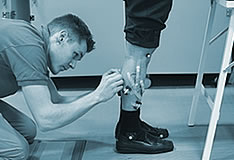Diagnosing balance disorders with Galvanic Vestibular Stimulation
 Galvanic Vestibular Stimulation (GVS) is a technique for activating the human balance organ within the inner ear. Although it has been used in basic science for decades, it has not made the transition to clinic. We aim to apply GVS to patients with balance disorders to determine its potential as a diagnostic clinical test. We will start by measuring eye movements and body sway evoked by GVS in healthy volunteers, and will compare these responses to those of patients with known pathology.
Galvanic Vestibular Stimulation (GVS) is a technique for activating the human balance organ within the inner ear. Although it has been used in basic science for decades, it has not made the transition to clinic. We aim to apply GVS to patients with balance disorders to determine its potential as a diagnostic clinical test. We will start by measuring eye movements and body sway evoked by GVS in healthy volunteers, and will compare these responses to those of patients with known pathology.
The research related to GVS was feature in the Daily Mail article Fall guys (and girls): The OAPs being put through rigorous jet pilot testing to find out why the elderly suffer falls
Dr Raymond Reynolds was also interviewed for Radio 4's 'Inside Science' programme. Listen to the episode here (Dr Reynolds features from 15mins 25s)
Over the age of 65 one in three adults will have at least one fall per year and that rises to about 50% of adults over the age of 85.
What are the outcomes of this research?
The ultimate outcome is to determine the utility of GVS as a diagnostic tool for balance disorders.
People involved